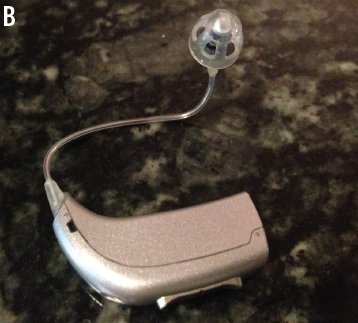Retained Foreign Body in the Ear Canal
A 10-year-old girl with moderate bilateral sensorineural hearing loss was seen in the otorhinolaryngology clinic for a follow-up visit. She wore her hearing aids regularly, both in school and at home.
Her mother reported that her daughter had been complaining for several weeks of fullness of the left ear, “like something is blocking it,” but the sensation did not interfere with her wearing the hearing aid. She denied pain or fullness in her ears during the visit.
On physical examination, the girl’s left ear canal was completely occluded with a gray, rubbery object with a rectangular recess in the center. The examining physician, who also is a hearing aid wearer, recognized the foreign body as the connector side of an open hearing aid dome. The mother reported that the dome had “gone missing” from the girl’s hearing aid approximately 2 weeks previously; she replaced it with a new one, and her daughter continued to wear the amplification device.

The dome was visualized with lighted direct otoscopy and removed easily through an otoscope speculum with Hartman alligator forceps (A). The external auditory canal and the tympanic membrane showed no signs of inflammation.
A foreign body in the external auditory canal, even a retained item, can be symptomatic or asymptomatic, and it may be discovered incidentally during examination.1
Persons with mild to moderate hearing loss who use hearing aid amplification often have open dome (nonocclusive) tips on their hearing aids (B), allowing them to take advantage of natural hearing in addition to amplified sound. These dome tips, unlike more rigid occlusive molds that fill the entire ear canal, are soft and compliant, and a wearer may not feel it if one becomes stuck accidentally in the ear canal.

Removal of some retained foreign bodies in the ear canal is fairly straightforward under direct visualization, particularly objects that are easily grasped, such as foam rubber, paper, or vegetable matter.2
Removal of objects that are not graspable, such as smooth or spherical objects like pebbles and beads, can be more difficult and can be associated with complications.3 Removal of such objects in most cases should be handled by a trained practitioner such as an otolaryngologist.
When deciding whether to refer a patient to a specialist for removal of a foreign body in the ear canal, it is worth noting that rates of successful removal can drop significantly after a failed first attempt.4
References
1. Ansley JF, Cunningham MJ. Treatment of aural foreign bodies in children. Pediatrics. 1998;101(4 pt 1):638-641.
2. Heim SW, Maughan KL. Foreign bodies in the ear, nose, and throat. Am Fam Physician. 2007;76(8):1185-1189.
3. Thompson SK, Wein RO, Dutcher PO. External auditory canal foreign body removal: management practices and outcomes. Laryngoscope. 2003;113(11):1912-1915.
4. Schulze SL, Kerschner J, Beste D. Pediatric external auditory canal foreign bodies: a review of 698 cases. Otolaryngol Head Neck Surg. 2002;127(1):73-78.


